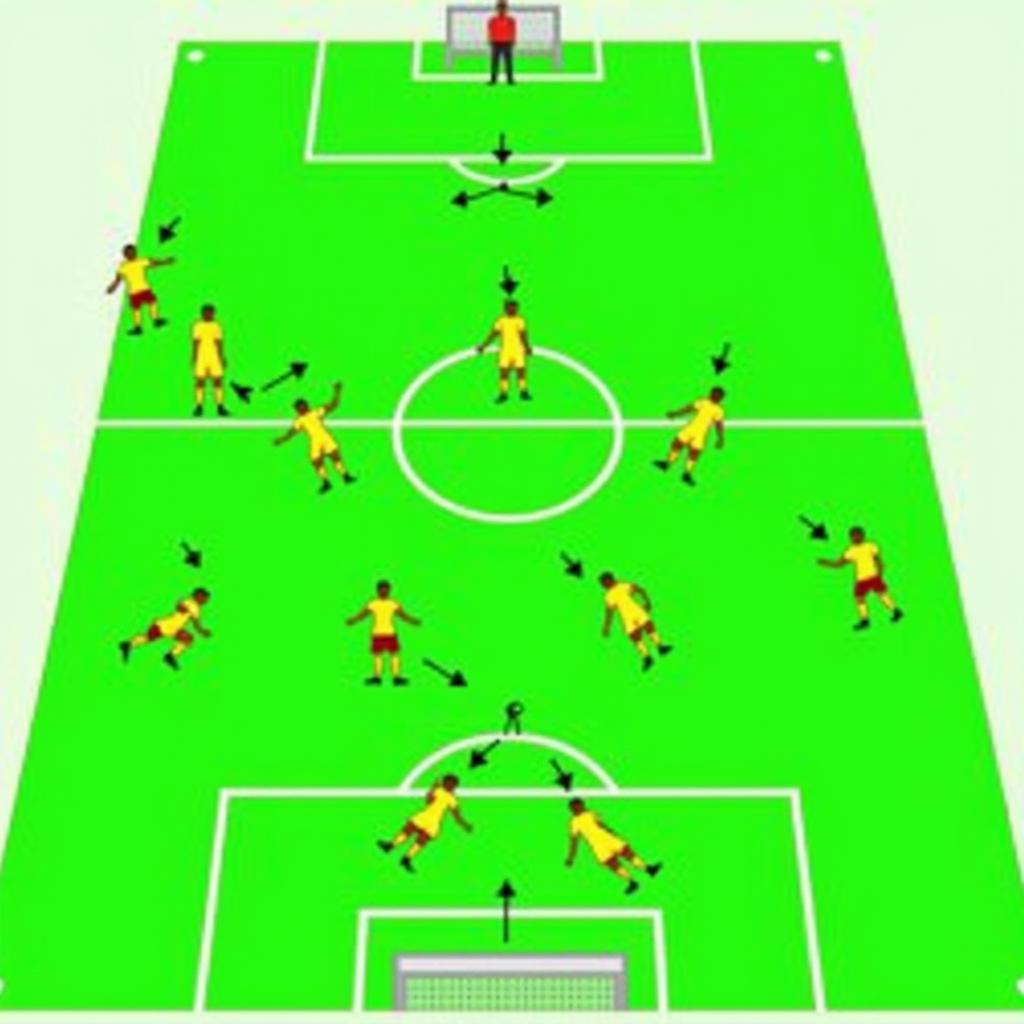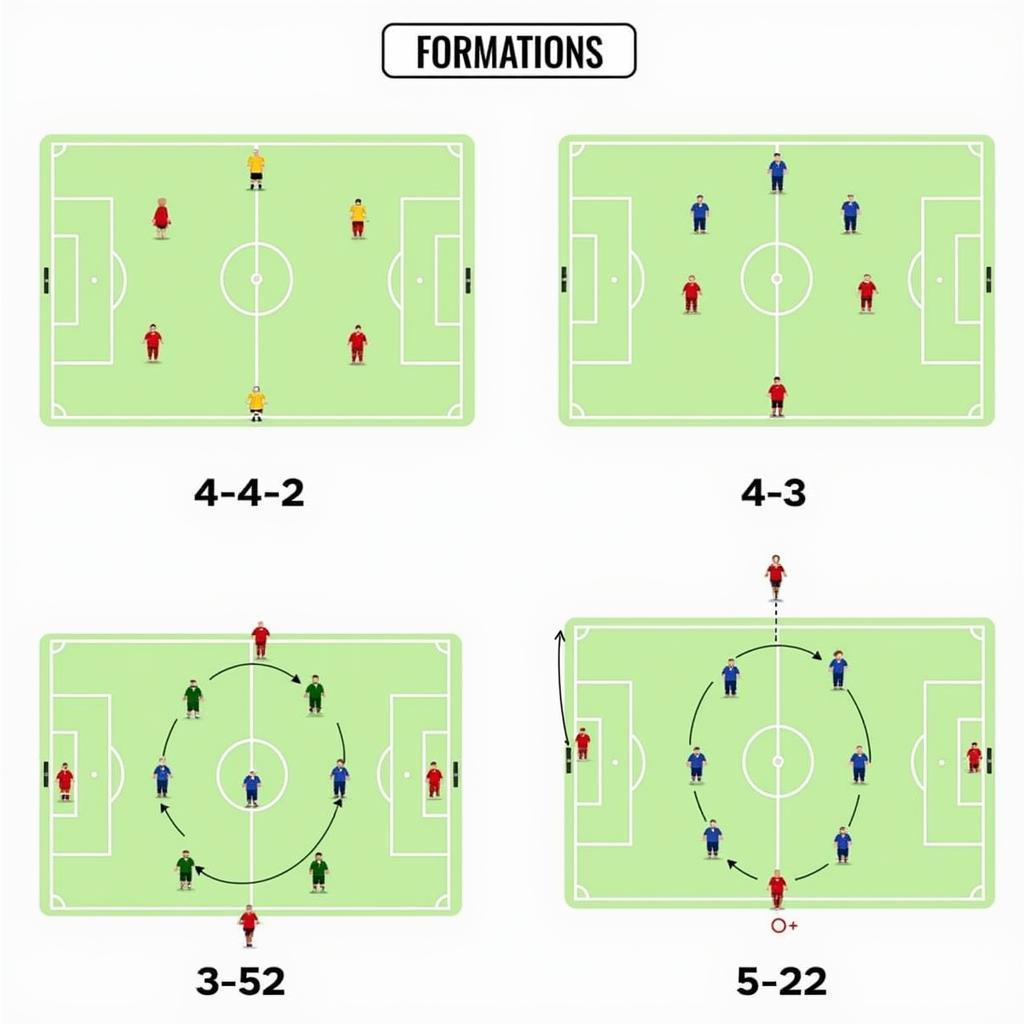How Many Players Make a Football Match?
November 7, 2024A football match, whether it’s the roar of the Champions League or a kickabout in the park, always boils down to a contest between two teams. But how many players make up each of these teams, and what roles do they play? This article explores the answer to the age-old question: “Moột Trận đá Bóng Gồm Bao Nhiêu Cầu Thủ?”
The Standard Eleven: Unpacking the Team Composition
In a standard football match, each team fields eleven players. This number includes ten outfield players and one goalkeeper. This setup has become the universally accepted standard for professional football, ensuring a balance between attack and defense while allowing for diverse tactical approaches.
The Goalkeeper: The Last Line of Defense
The goalkeeper’s primary responsibility is to prevent the opposing team from scoring. They are the only player allowed to use their hands within their designated penalty area, making them a crucial element in any team’s defensive strategy. A great goalkeeper can be a game-changer, pulling off spectacular saves and inspiring confidence in their teammates.
Defenders: Shielding the Goal
Defenders primarily focus on preventing the opposition from advancing towards the goal. They typically position themselves in front of the goalkeeper, forming a defensive line. Their roles vary, from central defenders who are strong in the air and tackle, to full-backs who provide width and support attacks.
Midfielders: Linking Defense and Attack
Midfielders operate in the central area of the pitch, connecting the defense and attack. They are responsible for winning possession, distributing the ball, creating scoring opportunities, and occasionally contributing goals themselves. Different types of midfielders exist, from defensive midfielders who focus on disrupting play, to attacking midfielders who are adept at creating chances.
Forwards: The Goal-Getters
Forwards are the primary attacking force of the team, tasked with scoring goals. Their positioning is usually closest to the opponent’s goal, and they rely on speed, skill, and finishing ability to find the back of the net. The number and style of forwards employed can vary depending on a team’s tactics.
 Football team formation with 11 players
Football team formation with 11 players
Variations and Exceptions: Beyond the Standard Eleven
While eleven players per team is the standard, certain situations can lead to variations in the number of players on the field. For example, in youth or amateur football, teams might play with fewer players, adapting to smaller pitch sizes and player availability.
Substitutions: Adapting to the Game
Teams are typically allowed to make a number of substitutions during a match, bringing in fresh players to replace those who are tired or injured, or to change tactical approaches. The specific rules regarding substitutions vary depending on the competition and governing body.
Sending Offs: Playing with Fewer Players
If a player receives a red card for a serious foul or misconduct, they are sent off the field, and their team must continue playing with fewer players. This can drastically impact the game’s dynamics, often forcing the shorthanded team to adopt a more defensive strategy.
 Football player being sent off with a red card
Football player being sent off with a red card
Why Eleven? The History and Logic Behind the Number
The choice of eleven players per team has its roots in the early days of organized football. While the exact reasons remain debated, it is believed that eleven players per side provided a good balance between covering the field adequately and maintaining a manageable team size. This number has stood the test of time, becoming an integral part of the sport’s identity.
Tactical Flexibility: Adapting with Eleven Players
Eleven players allow for a wide range of tactical formations and strategies. From the classic 4-4-2 to more complex systems like the 3-5-2 or the 4-3-3, the standard eleven offers coaches flexibility in how they deploy their players to achieve their desired playing style.
 Various football tactical formations
Various football tactical formations
Conclusion: The Essential Eleven
So, how many players make a football match? Eleven players on each team, totaling twenty-two players on the field, make a standard football match. This number has become fundamental to the sport, shaping its tactical complexities and strategic depth. From the goalkeeper to the forwards, each of the eleven players plays a vital role in their team’s pursuit of victory. Understanding the composition and dynamics of a football team enhances the spectator experience and deepens appreciation for the beautiful game.
FAQ
- Can a football team play with fewer than eleven players? Yes, in certain circumstances like sending offs or youth/amateur matches.
- Why are there eleven players on a football team? Historical reasons and tactical considerations led to this standard.
- What happens if a team has fewer than seven players? The match is typically abandoned.
- What are the different positions in football? Goalkeeper, defenders, midfielders, and forwards.
- How many substitutions are allowed in a football match? It varies depending on the competition and rules.
- What happens if a player receives a red card? They are sent off and cannot be replaced.
- Can a team make substitutions during extra time? Yes, most competitions allow for substitutions during extra time.
For any assistance, please contact us: Phone Number: 0396443476, Email: [email protected] Or visit our office at: 23 Tháng 3, Đắk Nia, Gia Nghĩa, Đắk Nông, Việt Nam. We have a 24/7 customer service team.